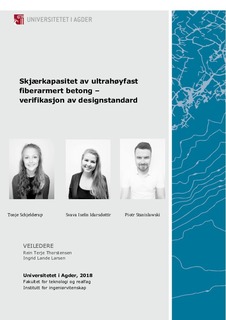Skjærkapasitet av ultrahøyfast fiberarmert betong – verifikasjon av designstandard
Master thesis
Permanent lenke
http://hdl.handle.net/11250/2562903Utgivelsesdato
2018Metadata
Vis full innførselSamlinger
Sammendrag
Ultra High Performance Fiber Reinforced Concrete (UHPFRC) is a concrete that is still not in use in
Norway. This is, as the name implies, a strong concrete, with high ductility from the fibres. To be able
to use this concrete in Norway in the future, it is necessary to develop a national standard for
UHPFRC. The concrete is in use in some countries, some of these are France, USA, Japan and Canada.
The French standard NF P18-710 is based on Eurocode 2, but it is customized for UHPFRC. The
method to calculate the shear capacity is different, both because of the concrete and because of the
use of fibres. To calculate how much the fibres will affect the shear capacity of the composite
material, it is necessary to go through bending tests, and then do calculations from the test results.
Both the mean value of the post-cracking strength along the shear crack, which is based on the
stress-crack opening curve, and the orientation factor K will have a crucial impact on the shear
capacity value from the fibres.
This is a master thesis written by three students at the University of Agder. The main goal of this
thesis is to compare the calculated shear capacity from the french standard to the practical shear
capacity. This was done by exposing UHPFRC beams to bending tests, to measure the shear capacity.
It was not possible to compare the calculated values to the practical results as the beams collapsed
because of moment capacity, and not shear capacity. Despite this, it is possible to assume that there
are some insecurities in the formulas from the French standard. The reason for this assumption is
that the calculated shear capacity for a beam with only fibres as reinforcement is higher than the
shear capacity for a beam that is reinforced with shear reinforcement.
Beskrivelse
Masteroppgave bygg BYG508 - Universitetet i Agder 2018

